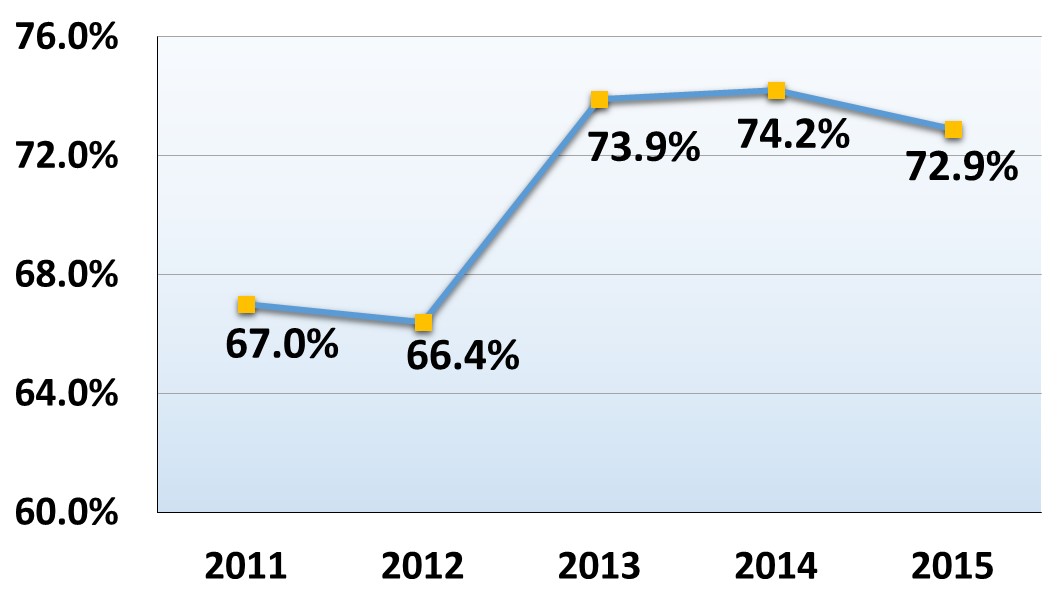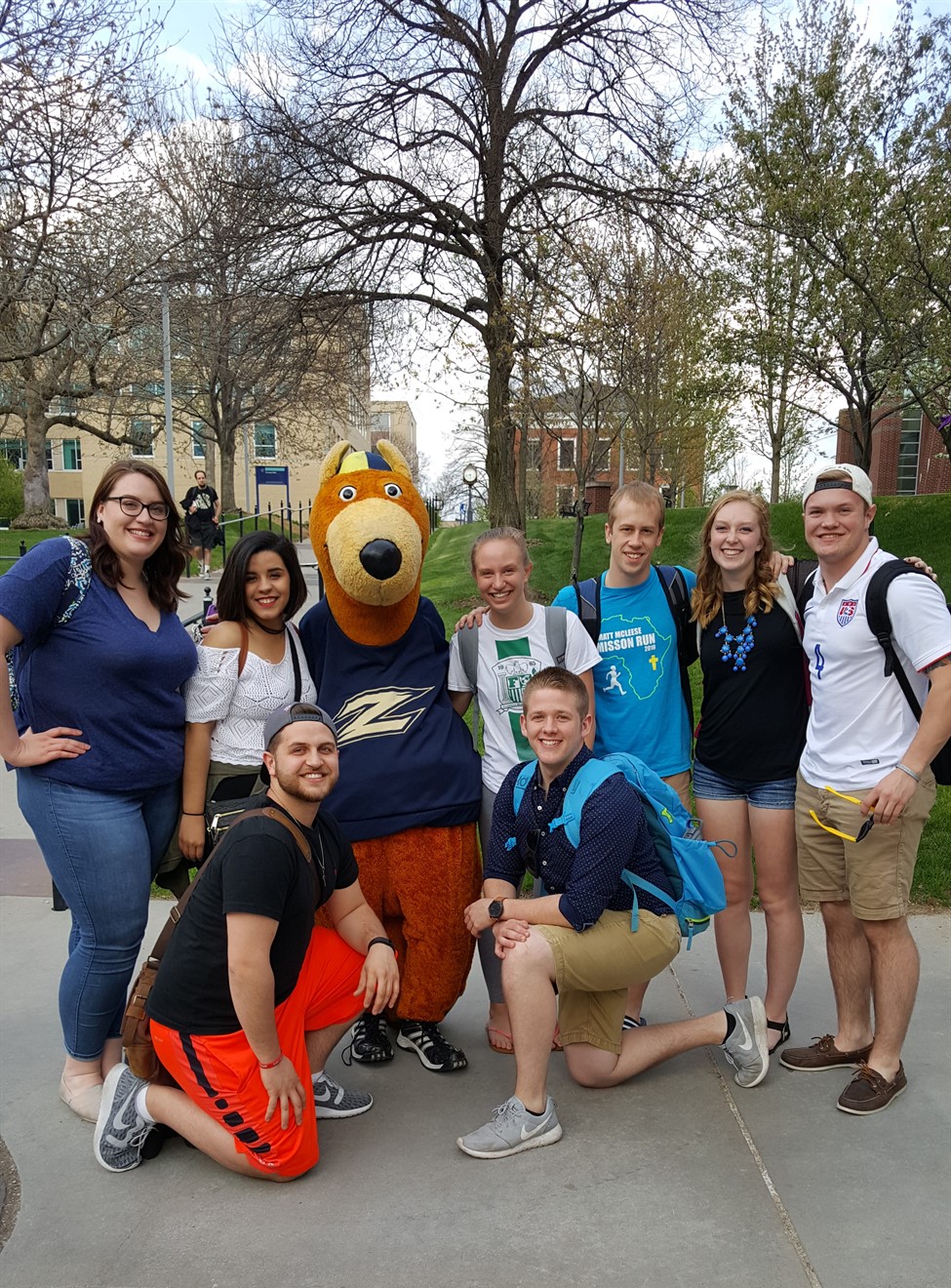IMPROVING RETENTION AND COMPLETION
Marking progress: Summary of initiatives
Results: First-year retention, 2011-15

Nearly 74 percent of UA students continued from their first year of study into the second year. That figure represents a 7.5% increase over the previous year's retention rate for first-time, full-time bachelor's degree-seeking students.
Advising innovations
- Mandatory advising -- As part of the retention plan, UA advising administrators recommended that all freshmen students be required to meet with an academic advisor beyond new student orientation. Most advising units now have required meetings with specific learning objectives for students. For example, the college ready advising group in CAASS has a mandatory appointment system for students during the first three semesters. Required topics range from study strategies to career planning to successful transition to the degree-granting college.
- Streamlining inter-college transfers -- To overcome blockages and time delays for students transitioning to their degree-granting colleges, a recommendation was made to automatically transfer qualified students. Currently, a query is being used to identify possibly qualified students and, upon verification of an academic advisor, the Inter-College Transfer is completed and forwarded without delay. Students are notified by the academic advisor and the receiving college is also notified of the ICT. Under construction is a system that will process the ICT electronically after grades are posted with notifications to all parties and all changes made automatically.
- Advisors in the residence halls and classrooms -- As part of the NOW initiative to encourage students to enroll into classes much earlier, advisors have gone into the residence halls to set up advising tables with technology and, at times, go door-to-door and offer to help students with scheduling for the next semester. Advisors have also been invited by faculty to address classes and remind students to schedule early to get the best classes at the best days and times. Additionally, advisors have set up tables in the Student Union and in the Recreation and Wellness Center to offer to assist with enrollment.
- Intentional academic advising -- Advising offices are organized to focus on students’ level of preparation and their corresponding needs. The benefits of this advising structure, designed for pre-majors in the Division of Student Success, include: 1) advising is tailored to students’ academic preparedness; 2) the advising model ensures increased student contact and more meaningful contact; 3) students are connected to majors and potential careers during the first year; and 4) advising centers and college advisors work together to streamline student’s pathway to an appropriate major.
Attendance Outreach
Research suggests that attendance and persistence may be directly correlated. In order to focus on the success and retention of UA students, faculty members are able to complete a form indicating if a particular student within their class has been struggling with attendance. Once the faculty member completes the form, the Office of the University Registrar will reach out to the indicated student offering support.
Retention Analytics
The University has contracted with a retention analytics system: the Student Success Collaborative (SSC) from the Education Advisory Board (EAB). In our research and RFP process, we found key attributes of this system that could have a positive impact on student retention and completion.
EAB developed this product as a tool to focus advisor efforts to best impact student success.
By measuring success in gateway courses the system uses predictive analytics to identify challenges and solutions for student academic success. The system predicts graduation rates based upon the student’s performance and can suggest other majors in which students may perform well.
Orientation and First Year Programming
New Student Orientation features a two-part process for incoming students, along with additional other first year programming initiatives to assist in the retention of students from their first to second year.
- From March to July, students make their first official connection with campus as a new student for advising and registration sessions.
- Prior to the start of classes, an extended weekend program, New Roo Weekend, spans the three days before the beginning of the fall term. Programmed with both informative and engaging activities, it's goal is to give each student the confidence to enter the college classroom with a mind to succeed and become a stronger member of the campus community by making important connections.
- Additional first year programming includes UA's annual Week of Welcome, Akron Adventures, UA's Common Reading Program, and Unlock Akron, are all available for incoming students to better connect with the UA community and other students.
Finish in Time
 Finish in Time is UA’s initiative to facilitate students’ timely degree completion. A surprising number of college-ready students do not enroll in 15-18 credits/semester, thus extending their time to degree and increasing their financial burden.
Finish in Time is UA’s initiative to facilitate students’ timely degree completion. A surprising number of college-ready students do not enroll in 15-18 credits/semester, thus extending their time to degree and increasing their financial burden.
The Division of Student Success will promote to new and continuing students, parents of new students, and the campus community the definition of “full time” student status as the completion of 30-36 credits per year. It will be emphasized that by following this schedule, students will complete their degrees in four years or less.
There are clear financial benefits of limiting the amount of time a student spends working while in school. All orientation and advising sessions will default to an enrollment in 15-18 credits, unless there is clear reason not to do so. Summer coursework will be promoted as a way to stay on track to “Finish in Time” if fewer than 30-36 credits are earned during the fall/spring academic year.
ZipStart summer program
Undergraduate new freshmen save money and can graduate sooner through ZipStart.
Students who are starting their college careers in the fall to take select gen-ed courses the preceding summer at a significant savings. They are able to earn more credits during their first year, thus building momentum toward graduation.
'Help a Zip' referral
Faculty, staff, parents, students and others use Help a Zip to notify campus professionals of students who are struggling with classwork or personal problems. When a referral is received, a team of campus professionals intervene and offer support.
Faculty members, critical to student engagement and success, are encouraged to talk with students about any concern, in addition to using Help a Zip.
Early Alert Initiatives
Research has demonstrated that the earlier students have contact with full-time faculty, the more likely they are to remain in school and succeed. The combination of full-time faculty contact with professional advisor and staff guidance and intervention, will improve retention and persistence. Although faculty and staff contact take many forms, measureable feedback in relation to student progress includes the use of early-term progress reports, primarily for the 100- and 200-level courses, where faculty enter satisfactory or unsatisfactory indicators during the second to fifth week of the term.
Learning assistants
Learning assistants are talented undergraduate students assigned to assist students in a particular course. The learning assistant attends the lectures and holds study sessions to help students succeed.
The learning assistant has already completed the course, so he or she has expertise in the material. Because the learning assistant is in the class, he or she knows the faculty member's pace, emphasis and approach.
Learning assistants most frequently assigned to math and science courses on our campus.
'Grades First' expansion
GradesFirst is a student retention software that is built on facilitating strong relationships between advisors and students. It uses technology to strengthen communications in a way that is timely, and specific to each student. It reaches students in a way that students access information.
Features of the system include a student self-service appointment tool, an electronic check-in kiosk in which to capture important student traffic data, and a calendar integration between GradesFirst and Outlook mail. Also, the system allows for an advanced student search by filtering information to identify specific information (registration, service indicators, grade point average ranges, among others), with resultant appointment campaigns and automatic appointment reminders. Both advisor and advising administrator can run reports through the system as an assessment tool toward measuring student learning outcomes and process delivery outcomes.
The system is unique in how it provides communication tools for advisors to develop relationships with their students. These features include two-way texting, click-to-call feature through an advisor text message, targeted communications, Facebook integration (through GradesFirst protected servers), communications routing, and communications capture through reports. In addition, the system has been vetted to be FERPA compliant.
First-Year Student Success Seminar
The University offers a student success course, The Akron Experience: University 101, that combines topics related to first-year experiences with career-planning elements to engage student early. The Akron Experience: University 101 is required of all new baccalaureate degree-seeking freshmen admitted on the emergent and preparatory pathways. College-ready students are strongly encouraged to participate in this course.
Learning Communities
Students participating in learning communities engage in structured learning experiences that foster connections with their peers, establish relationships with their faculty members and academic advisors, as well and enable them to form positive connections to the campus community.
For more information, see the Learning Communities page.
Peer Mentoring Program
The program, coordinated through the Office of Multicultural Development, has increased its number of mentored students to nearly 800. Peer Mentors are successful sophomores, juniors and seniors who have demonstrated the ability to relate well with first-year students from varied ethnic, social and cultural backgrounds. They serve as role models who lead and support incoming first-year students by setting a positive academic example, encouraging mentees to make good decisions as well as utilize campus resources that include tutoring, counseling, meeting with their academic advisors and faculty members, and getting involved with campus activities.
For more information, see the Peer Mentoring Services page.


